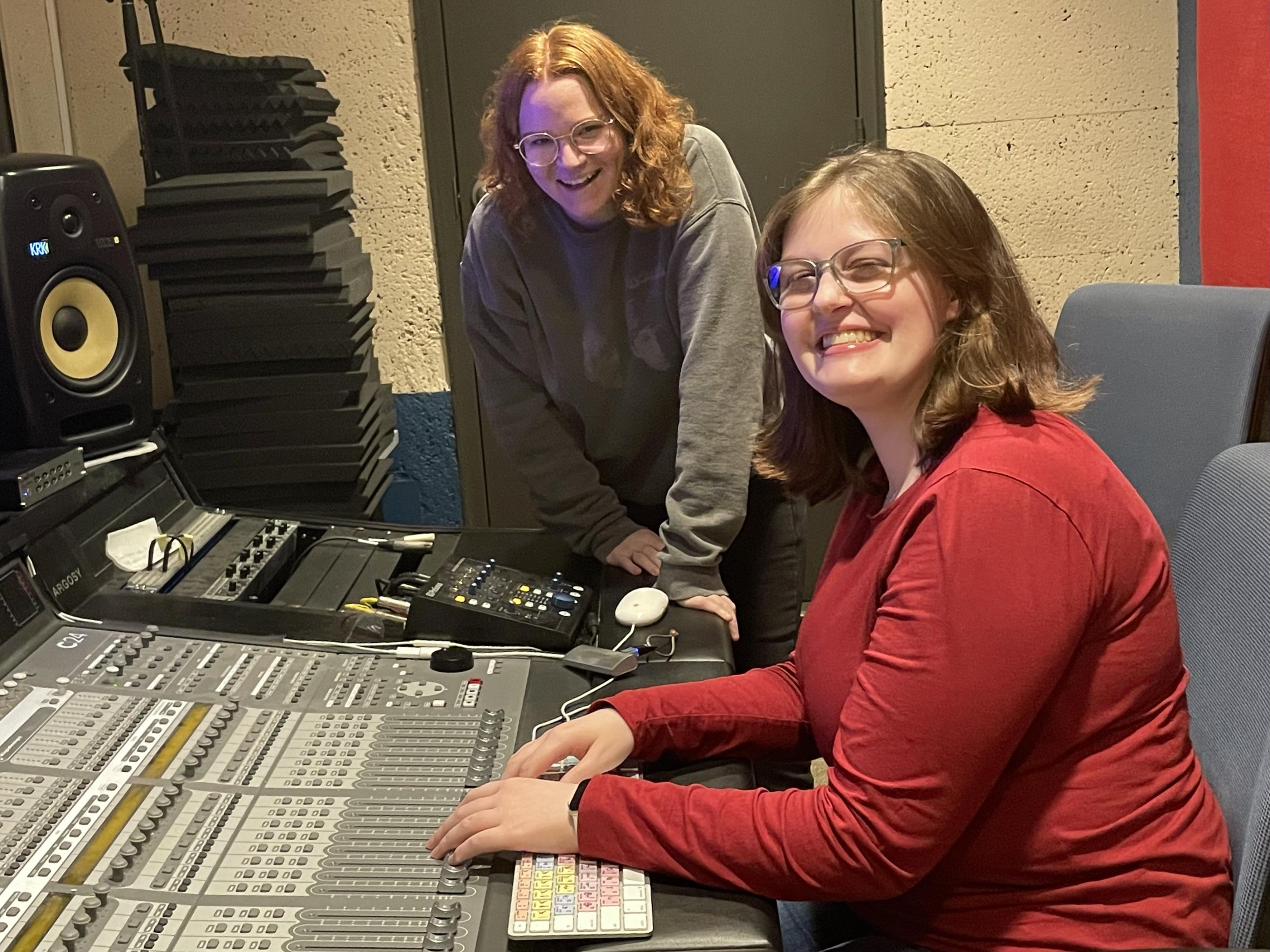Oswego students Samantha Keaney (left) and Jaime Hunter (right) working in the Lanigan Hall recording studio.
Oswego students Samantha Keaney and Jaime Hunter earned first place in the “Student Audio - Multimedia Sound Design” category at the Broadcast Education Association (BEA) Festival of Media Arts.
The pair submitted a class project they completed in the course BRC 308: "Sound for TV and Film I," taught by broadcasting faculty member Jeff Bradbury.
The BEA Festival accepts both student and faculty submissions internationally, with over 7,000 submissions from around 300 member institutions. In Keaney and Hunter’s case, they believe they had to beat out roughly 100 submissions in their category.
The project they submitted was an audio replacement from a scene in the animated film “Rango.” They learned about the festival with faculty support from both Bradbury and David Crider.
“Professor Bradbury was the one who suggested we submit [the project] to the BEA awards… He got us in touch with Crider and we submitted it,” said Keaney.
“I’ve had a few classes with professor Crider and he’s a big advocate for [the BEA awards],” said Hunter. “He talks about it in every class.”
Keaney says the weight of the honor didn’t sink in until after they won.
“I didn’t realize how big of a deal this competition was until we won… It’s faculty, staff submissions, all over the country, there were even some submissions from the UK,” said Keaney. “It’s a big deal for the college as well… the ranking for the best broadcast school in the country is solely based on this competition… that realization didn’t hit me until after we won. Like wow, we did really good."
Hands-on class experience
In BRC 308, students learn the full sound design process for television and film production. Throughout the semester, students recreate the sound design from one film or television episode of their choosing, using audio recorders to capture sounds needed for the scene, recording automated dialogue replacement (ADR) and mixing their project in a professional studio setting.
When reflecting on the creation of the project, Keaney said she appreciates the hands-on learning opportunities BRC 308 provided, especially learning foley, or re-recording sounds for film and television.
“Very few of the sounds we used in the project were from a music library,” said Keaney. “Most of them we recorded ourselves in either the foley studio or the ADR studio.
“In our case, we had a fully animated scene, so we had to redesign every single sound. Footsteps, glasses on the table. We had like flipping of cards, creaky doors, all of that we recorded live in a studio,” said Keaney. “As Jaime’s watching the playback of the scene, she’s simultaneously trying to match the footsteps to their footsteps and everything.”
Both of them appreciated the hands-on nature of the course, as it helped them absorb the material.
“I learn better with hands-on experience. It’s just totally different. [Bradbury] would also show us slides and explain Pro Tools and all the different parts… but it’s a totally different thing when you’re actually on a computer going into Pro Tools itself,” said Hunter. “Going into the studio and working to create the dialogue, setting up the microphones and headphones and then recording it. It’s a totally different experience.”
“Professor Bradbury has a props closet… there were just so many random quirky sounds,” said Keaney. “Even a block of wood. You can bang it on one thing and it makes one sound, and then you can bang it on something else and it makes another completely different sound.
“It’s one of the reasons I became a broadcasting major… I learned so much so quickly and I’m still learning so much because 90 percent of it is hands-on,” said Keaney. “Many of my classes don’t require a textbook or homework. It’s going into the studio and doing the work in class. Personally, I learn the best by doing, not by reading or watching someone else do it.”
Sense of belonging
As the pair reflected on their experience in the broadcasting and mass communication major at Oswego, they mentioned the sense of community, belonging and experiential learning opportunities. Keaney, who switched her major, says it was even better than anticipated.
“When I transferred to broadcasting and got to meet all of these really great people, professors, faculty, you can tell that everyone really wants you to succeed in this field and that kind of support was very refreshing," said Keaney, “It feels like a community. I know it’s just a major, but we all know each other and are best buddies, and we’re all learning from each other.”
“I had no idea what direction I wanted to go career-wise when I came to college. I was going blind,” said Hunter. “I took all those editing classes like [BRC 235: "Intro to Video Production"] with professor [Francisco] Suarez, I took post-production editing with professor [Marybeth] Longo and it was everything. I loved that class, those classes because it was a hands-on experience.”
Keaney and Hunter are both grateful for the faculty support that led to them receiving this award.
“I just want to reiterate how grateful I am for Professor Bradbury. He was there every step of the way encouraging us, validating us and our skills and helping us,” said Keaney. “He’s one of my favorite professors. You can tell he genuinely enjoys what he does, loves what he does and loves seeing his students succeed.”
Keaney and Hunter will both graduate in May 2024. The pair are currently applying for grants and set up a GoFundMe in hopes of attending the awards ceremony in Las Vegas.




